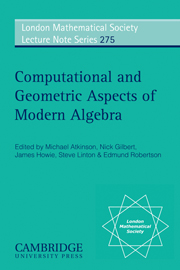Book contents
- Frontmatter
- Contents
- Foreword
- Participants
- 1 Lie Methods in Growth of Groups and Groups of Finite Width
- 2 Translation numbers of groups acting on quasiconvex spaces
- 3 On a term rewriting system controlled by sequences of integers
- 4 On certain finite generalized tetrahedron groups
- 5 Efficient computation in word-hyperbolic groups
- 6 Constructing hyperbolic manifolds
- 7 Computing in groups with exponent six
- 8 Rewriting as a special case of non-commutative Gröbner basis theory
- 9 Detecting 3-manifold presentations
- 10 In search of a word with special combinatorial properties
- 11 Cancellation diagrams with non-positive curvature
- 12 Some Applications of Prefix-Rewriting in Monoids, Groups, and Rings
- 13 Verallgemeinerte Biasinvarianten und ihre Berechnung
- 14 On groups which act freely and properly on finite dimensional homotopy spheres
- 15 On Confinal Dynamics of Rooted Tree Automorphisms
- 16 An asymptotic invariant of surface groups
- 17 A cutpoint tree for a continuum
- 18 Generalised triangle groups of type (2, m, 2)
7 - Computing in groups with exponent six
Published online by Cambridge University Press: 06 July 2010
- Frontmatter
- Contents
- Foreword
- Participants
- 1 Lie Methods in Growth of Groups and Groups of Finite Width
- 2 Translation numbers of groups acting on quasiconvex spaces
- 3 On a term rewriting system controlled by sequences of integers
- 4 On certain finite generalized tetrahedron groups
- 5 Efficient computation in word-hyperbolic groups
- 6 Constructing hyperbolic manifolds
- 7 Computing in groups with exponent six
- 8 Rewriting as a special case of non-commutative Gröbner basis theory
- 9 Detecting 3-manifold presentations
- 10 In search of a word with special combinatorial properties
- 11 Cancellation diagrams with non-positive curvature
- 12 Some Applications of Prefix-Rewriting in Monoids, Groups, and Rings
- 13 Verallgemeinerte Biasinvarianten und ihre Berechnung
- 14 On groups which act freely and properly on finite dimensional homotopy spheres
- 15 On Confinal Dynamics of Rooted Tree Automorphisms
- 16 An asymptotic invariant of surface groups
- 17 A cutpoint tree for a continuum
- 18 Generalised triangle groups of type (2, m, 2)
Summary
Abstract. We have investigated the nature of sixth power relations required to provide proofs of finiteness for some two-generator groups with exponent six. We have solved various questions about such groups using substantial computations. In this paper we elaborate on some of the calculations and address related problems for some three-generator groups with exponent six.
INTRODUCTION
Motivated by an aim to get estimates for the number and length of sixth power relations which suffice to define groups with exponent six, we studied finiteness proofs for presentations of such groups in. We tried to find relatively small sets of defining relations for various groups, with a view to improving our understanding of finiteness proofs.
We denote the free group on d generators with exponent n by B(d, n) and generally use notation as in. One question we would very much like to be able to answer is whether B(2,6) can be defined without using too many sixth powers. Here we focus on the computational components of the process, giving sample code which solves some associated problems.
We showed that B(2,6) has a presentation on 2 generators with 81 relations, which is derived from a polycyclic presentation. Here in Section 3 we give a program to construct a polycyclic presentation for B(2,6) which shows the structure of the group. If only sixth power relations are used, we showed that M. Hall's finiteness proof yields that fewer than 2124 sixth powers can define B(2,6). On the other hand the best lower bound we have proved is that at least 22 sixth powers are needed [5, Theorem 1].
- Type
- Chapter
- Information
- Computational and Geometric Aspects of Modern Algebra , pp. 87 - 100Publisher: Cambridge University PressPrint publication year: 2000

